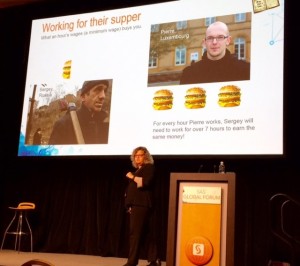 When you attend SAS® Global Forum - a conference where you’re surrounded by data scientists, programmers and those who grew up as the smartest people in the room – you expect to hear talk about big data and advanced analytics.
When you attend SAS® Global Forum - a conference where you’re surrounded by data scientists, programmers and those who grew up as the smartest people in the room – you expect to hear talk about big data and advanced analytics.
What you don’t expect to hear are compelling messages about the importance of art, storytelling…and unicorns.

But Emma Warrillow, President of Data Insight Group, Inc., couldn’t have been more convincing in her April 19 session highlighting the magic formula for becoming a well-sought-after marketing analyst. Her first hint: It requires much more than good programming skills.
She believes in the marriage of art and science. “When you put those two together, that’s where you get the wonder,” she said.
Wonder? Maybe that’s where unicorns come in.
In a sense, perhaps. Actually, unicorns – a rare breed of marketing technologists who understand both marketing and marketing technology (with a nod to John Ellett, contributor to Forbes) – are those who take the time to be curious and recognize that storytelling and imagery are like an analyst’s Trojan horse. Warrillow says they’re the way you get in.
For the data story to have real power, she believes, it needs to be memorable, impactful and personal. “Ask what the business will do with the results,” she said. “Think about what the listener might tell their boss or their coworker at the water cooler. That will be memorable.”
Today’s data visualization products make this easier than ever before. To build new skills in these seemingly foreign areas, she also suggested tapping into the power of user groups and creative teams in other parts of the organization.
Warrillow offered five tips to becoming that rare breed unicorn:
- Take time to align your analytic objectives with business objectives.
- Ask yourself what questions the business is asking. Insist on time to be curious and wonder.
- Tell stories to help your audience relate both rationally and emotionally to your message.
- Match the picture to the content and ensure it is telling the story.
- Look for ways that new technology may provide you with more efficient and effective ways to do your job.
“It’s a tall order,” she said. “Unicorns are rare and they’re hard to find. But the more you can take the time to understand all the pieces, the better analyst you’re going to be.”
Let the magic begin.
View the full paper
View the full presentation


2 Comments
Thanks Krystian and Becky
I had a great conversation with a SAS programmer on the way home on the plane; he had recently started working in a marketing group, after previously being part of an IT one. He said he realized during the presentation that this was entirely why his work was feeling unsatisfying. He was being given tasks to do - and invariably to redo once the business saw the results and realized that wasn't what they wanted. He said he was going to start asking WHY more often and recommend the solution rather than take orders.
I do hope he'll let me know how it goes!
I am totally agree with Emma and John. In today's challenging business environment it's very important to stimulate business creation and growth by asking: 'what the business will do with the results'.